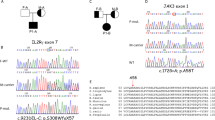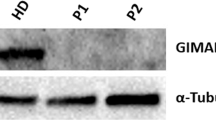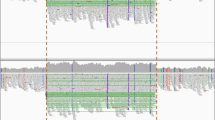Abstract
Severe combined immunodeficiency (SCID) is one of the severe inborn errors of the immune system associated with life-threatening infections. Variations in SCID phenotypes, especially atypical SCID, may cause a significant delay in diagnosis. Therefore, SCID patients need to receive an early diagnosis. Here, we describe the clinical manifestations and genetic results of four SCID and atypical SCID patients. All patients (4 males and 4 females) in early infancy presented with SCID phenotypes within 6 months of birth. The mutations include RAG2 (p.I273T,p.G44X), IL7R (p.F361WfsTer17), ADA (c.780+1G>A), JAK3 (p.Q228Ter), LIG4 (p.G428R), and LAT (p.Y207fsTer33), as well as a previously reported missense mutation in RAG1 (p.A444V). The second report of LAT deficiency in SCID patients is presented in this study. Moreover, all variants were confirmed in patients and their parents as a heterozygous state by Sanger sequencing. The results of our study expand the clinical and molecular spectrum associated with SCID and leaky SCID phenotypes and provide valuable information for the clinical management of the patients.
This is a preview of subscription content, access via your institution
Access options
Subscribe to this journal
Receive 6 digital issues and online access to articles
$119.00 per year
only $19.83 per issue
Buy this article
- Purchase on Springer Link
- Instant access to full article PDF
Prices may be subject to local taxes which are calculated during checkout



Similar content being viewed by others
Data availability
The data are available on request.
References
Ozturk E, Catak MC, Kiykim A, Baser D, Bilgic Eltan S, Yalcin K, et al. Clinical and laboratory factors affecting the prognosis of severe combined immunodeficiency. J Clin Immunol. 2022;42:1036–50.
Fischer A, Notarangelo LD, Neven B, Cavazzana M, Puck JM. Severe combined immunodeficiencies and related disorders. Nat Rev Dis Prim. 2015;1:15061.
Fazlollahi MR, Pourpak Z, Hamidieh AA, Movahedi M, Houshmand M, Badalzadeh M, et al. Clinical, laboratory, and molecular findings for 63 patients with severe combined immunodeficiency: a decade´s experience. J Investig Allergol Clin Immunol. 2017;27:299–304.
Cirillo E, Cancrini C, Azzari C, Martino S, Martire B, Pession A, et al. Clinical, immunological, and molecular features of typical and atypical severe combined immunodeficiency: report of the Italian primary immunodeficiency network. Front Immunol. 2019;10:1908.
Lim CK, Abolhassani H, Appelberg SK, Sundin M, Hammarstrom L. IL2RG hypomorphic mutation: identification of a novel pathogenic mutation in exon 8 and a review of the literature. Allergy Asthma Clin Immunol. 2019;15:2.
Cattaneo F, Recher M, Masneri S, Baxi SN, Fiorini C, Antonelli F, et al. Hypomorphic Janus kinase 3 mutations result in a spectrum of immune defects, including partial maternal T-cell engraftment. J Allergy Clin Immunol. 2013;131:1136–45.
Sundin M, Uhlin M, Gaballa A, Ramme K, Kolios AG, Marits P, et al. Late presenting atypical severe combined immunodeficiency (SCID) associated with a novel missense mutation in DCLRE1C. Pediatr Allergy Immunol. 2018;29:108–11.
Volk T, Pannicke U, Reisli I, Bulashevska A, Ritter J, Bjorkman A, et al. DCLRE1C (ARTEMIS) mutations causing phenotypes ranging from atypical severe combined immunodeficiency to mere antibody deficiency. Hum Mol Genet. 2015;24:7361–72.
Dvorak CC, Haddad E, Buckley RH, Cowan MJ, Logan B, Griffith LM, et al. The genetic landscape of severe combined immunodeficiency in the United States and Canada in the current era (2010-2018). J Allergy Clin Immunol. 2019;143:405–7.
Felgentreff K, Perez-Becker R, Speckmann C, Schwarz K, Kalwak K, Markelj G, et al. Clinical and immunological manifestations of patients with atypical severe combined immunodeficiency. Clin Immunol. 2011;141:73–82.
Perez E. Future of therapy for inborn errors of immunity. Clin Rev Allergy Immunol. 2022;63:75–89.
Shearer WT, Dunn E, Notarangelo LD, Dvorak CC, Puck JM, Logan BR, et al. Establishing diagnostic criteria for severe combined immunodeficiency disease (SCID), leaky SCID, and Omenn syndrome: the Primary Immune Deficiency Treatment Consortium experience. J Allergy Clin Immunol. 2014;133:1092–8.
Bousfiha A, Jeddane L, Picard C, Al-Herz W, Ailal F, Chatila T, et al. Human inborn errors of immunity: 2019 update of the IUIS phenotypical classification. J Clin Immunol. 2020;40:66–81.
Kopanos C, Tsiolkas V, Kouris A, Chapple CE, Albarca Aguilera M, Meyer R, et al. VarSome: the human genomic variant search engine. Bioinformatics. 2018;35:1978–80.
Richards S, Aziz N, Bale S, Bick D, Das S, Gastier-Foster J, et al. Standards and guidelines for the interpretation of sequence variants: a joint consensus recommendation of the American College of Medical Genetics and Genomics and the Association for Molecular Pathology. Genet Med. 2015;17:405–24.
Villa A, Sobacchi C, Notarangelo LD, Bozzi F, Abinun M, Abrahamsen TG, et al. V(D)J recombination defects in lymphocytes due to RAG mutations: severe immunodeficiency with a spectrum of clinical presentations. Blood. 2001;97:81–8.
Goda V, Malik A, Kalmar T, Maroti Z, Patel B, Ujhazi B, et al. Partial RAG deficiency in a patient with varicella infection, autoimmune cytopenia, and anticytokine antibodies. J Allergy Clin Immunol Pr. 2018;6:1769–71.e2.
McGrath-Morrow SA, Ndeh R, Helmin KA, Khuder B, Rothblum-Oviatt C, Collaco JM, et al. DNA methylation and gene expression signatures are associated with ataxia-telangiectasia phenotype. Sci Rep. 2020;10:7479.
Barata JT, Durum SK, Seddon B. Flip the coin: IL-7 and IL-7R in health and disease. Nat Immunol. 2019;20:1584–93.
Zhang W, Sommers CL, Burshtyn DN, Stebbins CC, DeJarnette JB, Trible RP, et al. Essential role of LAT in T cell development. Immunity. 1999;10:323–32.
Zhang W, Irvin BJ, Trible RP, Abraham RT, Samelson LE. Functional analysis of LAT in TCR-mediated signaling pathways using a LAT-deficient Jurkat cell line. Int Immunol. 1999;11:943–50.
Keller B, Zaidman I, Yousefi OS, Hershkovitz D, Stein J, Unger S, et al. Early onset combined immunodeficiency and autoimmunity in patients with loss-of-function mutation in LAT. J Exp Med. 2016;213:1185–99.
Bacchelli C, Moretti FA, Carmo M, Adams S, Stanescu HC, Pearce K, et al. Mutations in linker for activation of T cells (LAT) lead to a novel form of severe combined immunodeficiency. J Allergy Clin Immunol. 2017;139:634–42.e5.
Kuo CY, Garabedian E, Puck J, Cowan MJ, Sullivan KE, Buckley RH, et al. Adenosine deaminase (ADA)-deficient severe combined immune deficiency (SCID) in the US Immunodeficiency Network (USIDNet) Registry. J Clin Immunol. 2020;40:1124–31.
Li M, Chen Z, Zhu Y, Chen J. Disseminated Bacille Calmette-Guérin infection in a patient with severe combined immunodeficiency caused by JAK3 gene mutation. Pediatr Dermatol. 2019;36:672–6.
Stepensky P, Keller B, Shamriz O, NaserEddin A, Rumman N, Weintraub M, et al. Deep intronic mis-splicing mutation in JAK3 gene underlies T-B+NK- severe combined immunodeficiency phenotype. Clin Immunol. 2016;163:91–5.
El Hawary R, Meshaal S, Mauracher AA, Opitz L, Abd Elaziz D, Lotfy S, et al. Whole-exome sequencing of T(-) B(+) severe combined immunodeficiency in Egyptian infants, JAK3 predominance and novel variants. Clin Exp Immunol. 2021;203:448–57.
Qamar F, Junejo S, Qureshi S, Seleman M, Bainter W, Massaad M, et al. A novel mutation in the JH4 domain of JAK3 causing severe combined immunodeficiency complicated by vertebral osteomyelitis. Clin Immunol. 2017;183:198–200.
Sun B, Chen Q, Wang Y, Liu D, Hou J, Wang W, et al. LIG4 syndrome: clinical and molecular characterization in a Chinese cohort. Orphanet J Rare Dis. 2020;15:131.
Altmann T, Gennery AR. DNA ligase IV syndrome; a review. Orphanet J Rare Dis. 2016;11:137.
Felgentreff K, Baxi SN, Lee YN, Dobbs K, Henderson LA, Csomos K, et al. Ligase-4 deficiency causes distinctive immune abnormalities in asymptomatic individuals. J Clin Immunol. 2016;36:341–53.
Taskiran EZ, Sonmez HE, Kosukcu C, Tavukcuoglu E, Yazici G, Esendagli G, et al. A novel missense LIG4 mutation in a patient with a phenotype mimicking Behçet’s disease. J Clin Immunol. 2019;39:99–105.
Taki M, Miah T, Secord E. Newborn screening for severe combined immunodeficiency. Pediatr Clin North Am. 2019;66:913–23.
Cuvelier GDE, Logan BR, Prockop SE, Buckley RH, Kuo CY, Griffith LM, et al. Outcomes following treatment for ADA-deficient severe combined immunodeficiency: a report from the PIDTC. Blood. 2022;140:685–705.
Funding
This work was supported by Elite Researcher Grant Committee under award number 958326 from the National Institutes for Medical Research Development (NIMAD), Tehran, Iran; Immunology, Asthma & Allergy Research Institute, Tehran University of Medical Science, Tehran, Iran; B.G. is funded by the Deutsche Forschungsgemeinschaft (GR1617/14-1/iPAD; SFB1160/2_B5; RESIST–EXC 2155–Project ID 390874280; and CIBSS–EXC-2189–Project ID 390939984) and the BMBF (GAIN 01GM1910A) and S.B. is funded by Service d’Immunologie Biologique, Plateau Technique de Biologie, Pôle de Biologie, Nouvel Hôpital Civil, 1 place de l’Hôpital, 67091 Strasbourg, France.
Author information
Authors and Affiliations
Contributions
Conceptualization: ZP, ZA, MRF, SB; Methodology: ZA, MM, HH, MB, RC, AM, ACGO, MP; Validation: ZA, MM, HH, MB, RC, AM, MSB; Formal analysis: ZA, MM, HH, MB; Investigation: ZA, RC, AM, ACGO, MP; Clinical data and analysis: ZP, MRF, MS, MF, MM and LM; Supervision: ZP, ZA, MRF, SB, BG, Writing Original Drafts: ZA, ZP MRF; Revision: MRF, ZP, ZA SB; All authors read and approved the manuscript before submission.
Corresponding authors
Ethics declarations
Competing interests
The authors declare no competing interests.
Ethics approval and consent to participate
This study was performed in line with the principles of the Declaration of Helsinki. Approval was granted by the Ethics Committee of Immunology, Asthma & Allergy Research Institute. Written informed consent was obtained from the patients’ parents.
Additional information
Publisher’s note Springer Nature remains neutral with regard to jurisdictional claims in published maps and institutional affiliations.
Rights and permissions
Springer Nature or its licensor (e.g. a society or other partner) holds exclusive rights to this article under a publishing agreement with the author(s) or other rightsholder(s); author self-archiving of the accepted manuscript version of this article is solely governed by the terms of such publishing agreement and applicable law.
About this article
Cite this article
Alizadeh, Z., Fazlollahi, M.R., Mazinani, M. et al. Clinical, immunological and molecular findings of 8 patients with typical and atypical severe combined immunodeficiency: identification of 7 novel mutations by whole exome sequencing. Genes Immun 24, 207–214 (2023). https://doi.org/10.1038/s41435-023-00215-w
Received:
Revised:
Accepted:
Published:
Issue Date:
DOI: https://doi.org/10.1038/s41435-023-00215-w



